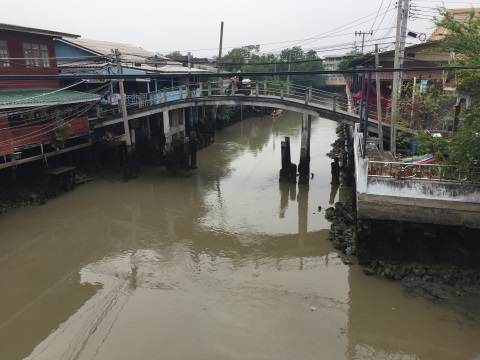| Back to Back Issues Page |
 |
|
Bangkok Travelbug May 2018 Ban Sakhla the water community Samut Prakarn May 16, 2018 |
| Hello
Wat Sakhla Wat Sakhla is located on 27 rai (4.32 hectares or 10.67 acres) of low-lying and marshy land near the coast of Samut Prakarn about 20 km south of Bangkok. Judging from the relics (sema or boundary markers for the ubosot) Buddha images unearthed when the ubosot (ordination hall) was raised, Wat Sakhla dates back to the late Ayutthaya period 1700s – 1800s. The Ban Sakhla Community is built around this temple which serves as a centre for community and religious activities. Visitors driving to Ban Sakhla will arrive at the carpark in Wat Sakhla first. There are two places of interest in this temple. The first thing that catches your eye is this leaning prang*, a result of the subsiding soil. 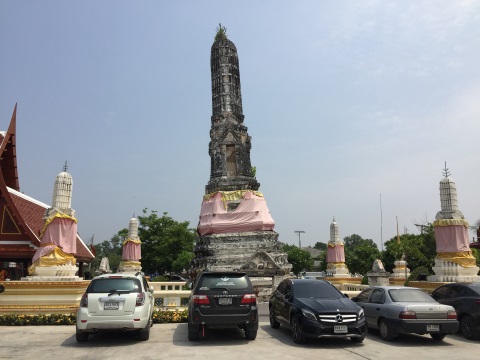
The leaning prang in Wat Sakhla *Prang – a conical tower, broad at the base and tapers to the top The other attraction in Wat Sakhla is the sala kanprian or multi-purpose hall, a raised wooden building; the space below displays old photos of the community and the room upstairs houses the Ban Sakhla Museum where we will be going next. 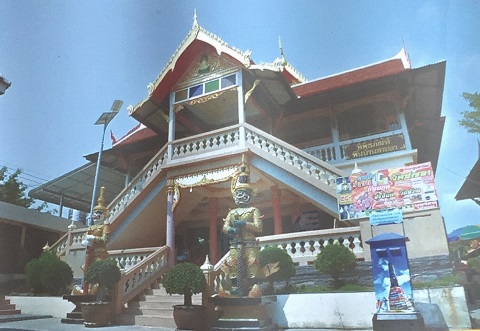
Ban Sakhla Museum Contents Ban Sakhla Museum View the photos downstairs first, of interest are the photos showing villagers building a road in the community in 1966. 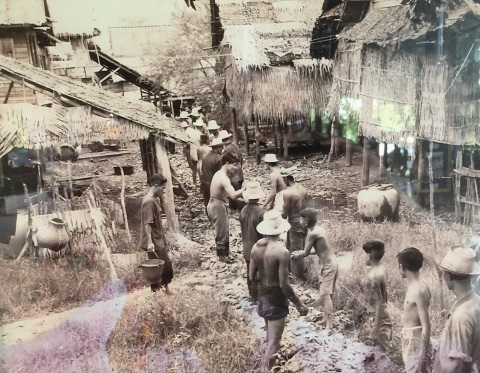
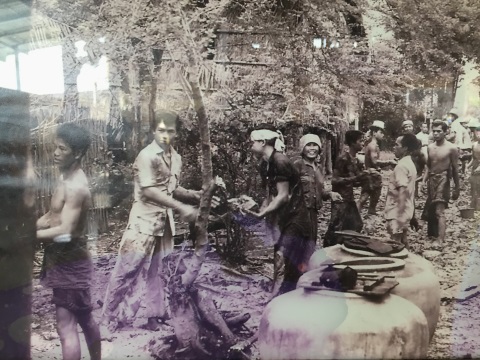
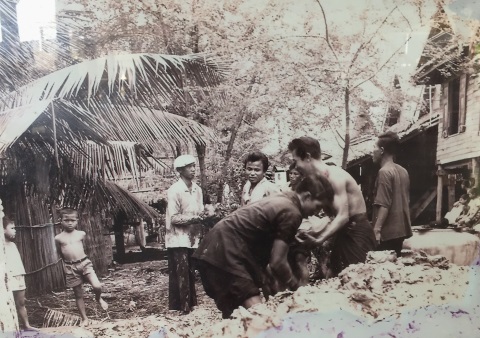
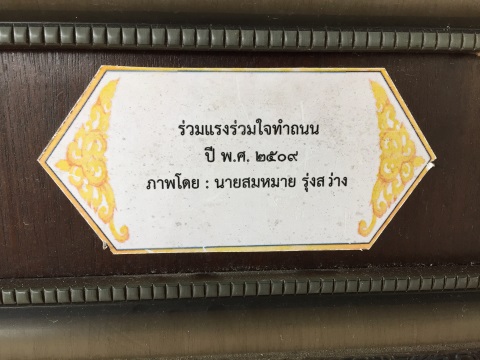
Villagers getting together to build a road – 2509 BE (1966) Other photo displays show villagers using a manual roller used to crush the salt, collecting salt from the salt farms, a main occupation previously and children lining up in a procession. 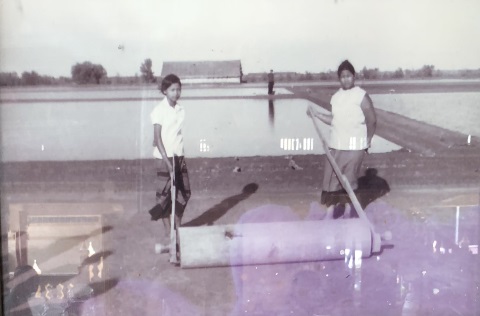
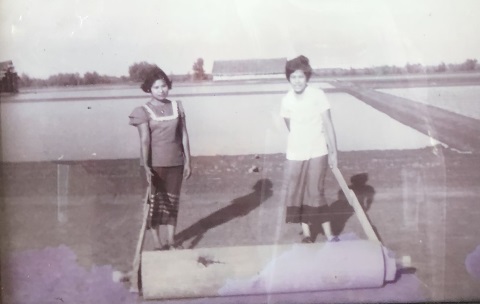
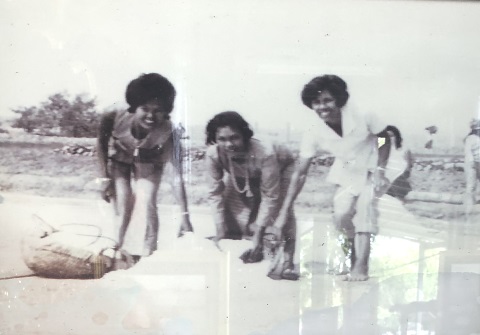
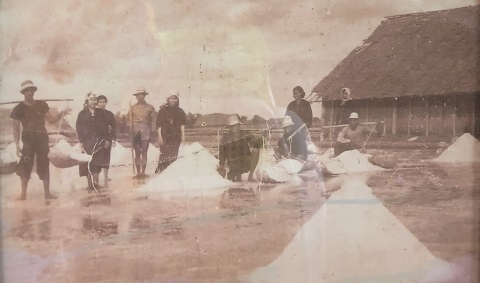
Crushing the salt and sweeping the salt into piles 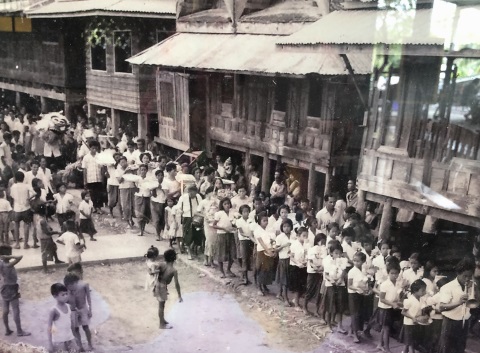
Children lining up with gifts probably during a festival The museum upstairs has more interesting displays showing the way of life of the people in the Ban Sakhla Community. The sandstone and clay relics on display were dug up when the ubosot and viharn (assembly hall) had to be raised because of the subsiding soil in the area. These relics are estimated to be at least 250 years old, around the late 1700s. 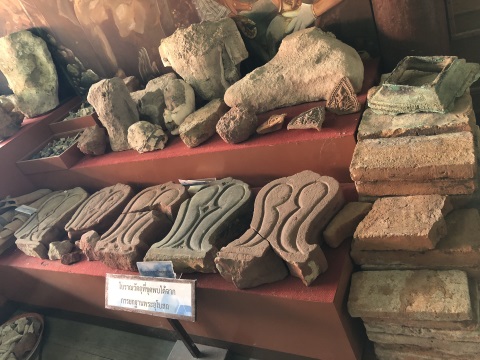
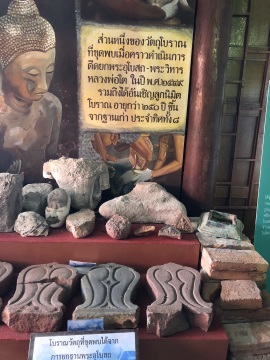
Relics dating back to the Ayutthaya period The legend of Ban Sakhla dates back to the reign of King Rama I (1782 – 1809) when Burma launched a massive invasion of Siam. All the able-bodied men in the village were conscripted for military service leaving only the women, children and old folks behind. When a raiding party of Burmese foraging for food threatened the village, the women rallied everyone and fought off the Burmese. From then on, the village was known as Ban Sao Khla (village of brave ladies), Sao Khla overtime became Sakhla. 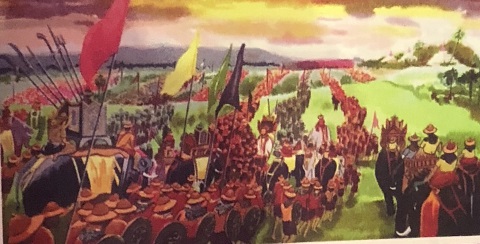
War of the Nine Armies when Burma invaded Siam in 1795 Salt farms were main livelihood of residents of Ban Sakhla in the early days. This done during the hot season when ponds are dried up. Sea water is drained into the first pond and exposed to the sun, then drained into second pond and then a third till the water has evaporated and the salt deposits are raked into piles and collected. 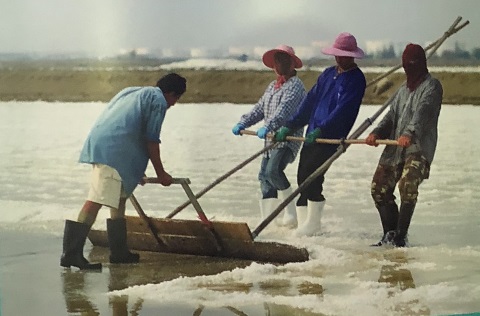
Raking in the salt The first pond that was emptied will then be filled with sea water again and the process is repeated. There were so many salt farms here that the name of the tambon (sub-district was changed from Tambon Ban Sakhla to Tambon Na Kluea (salt farm). Fish, prawn and crab baskets indicate the other occupations of the people here. 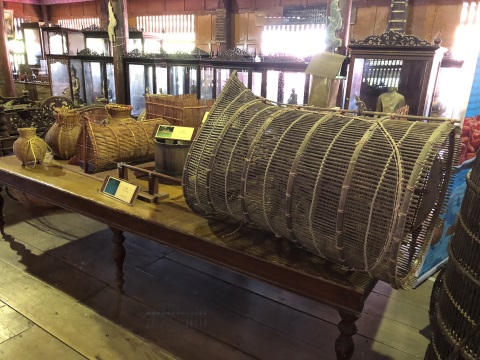
Fishing baskets 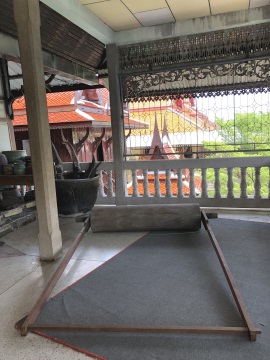
The roller used to crush salt preserved from the salt farming days Before there was electricity and water supplies to the community, kerosene lamps were used for lighting and water urns to collect rain water for personal consumption. 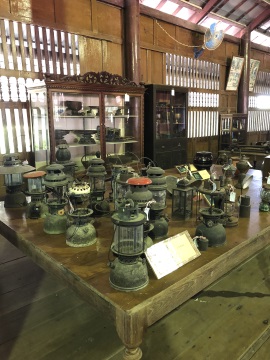
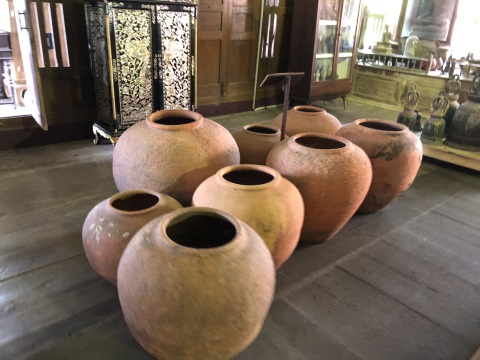
Before electricity and water supplies were available There is also a considerable collection of Buddha statues both in the main room and the adjoining room of the museum. 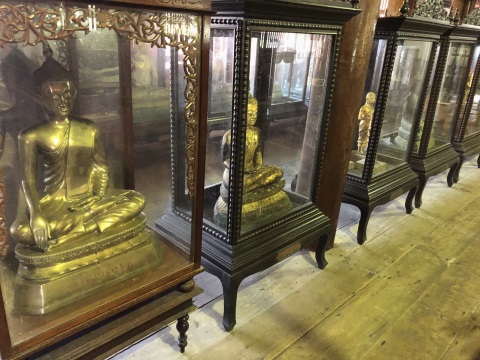
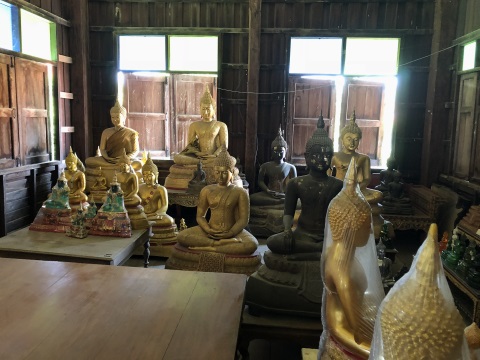
Buddha statues in the main room (top) and adjoining room (bottom) Contents Old Ban Sakhla Market The old Ban Sakhla Market is just across the arched bridge to the east of Wat Sakhla, it consists of rows of old wooden houses with shops selling a variety of goods. Though it was a holiday on Friday the day of our visit, not all the shops were open. They usually open on Saturdays and Sundays when there are more visitors. 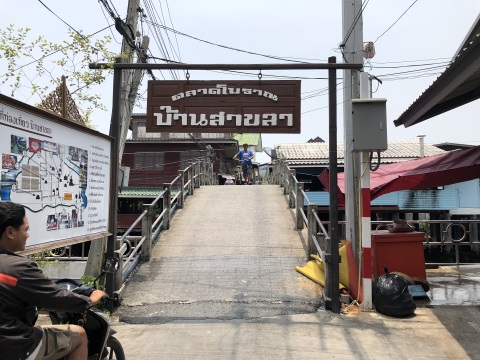
Bridge leading to the old Ban Sakhla Market 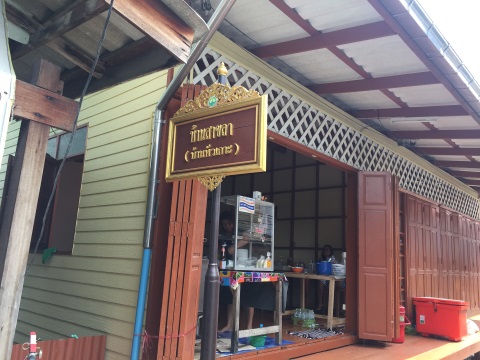
One of the shops that was open The houses are separated by neat concrete walkways forming the narrow lanes through the community with quaint road signs to show the different lanes. The houses are built on stilts with water below when it's high tide and rows of houses are separated by rivers with people travelling around the community in boats. 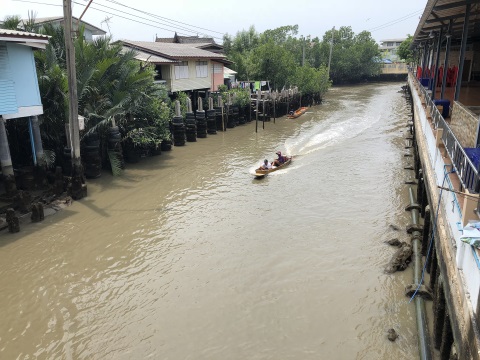
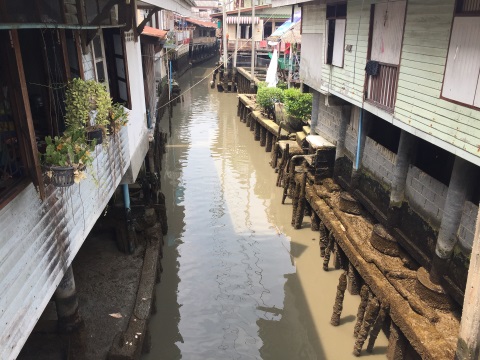
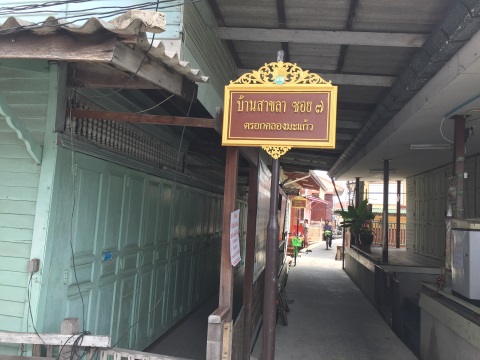
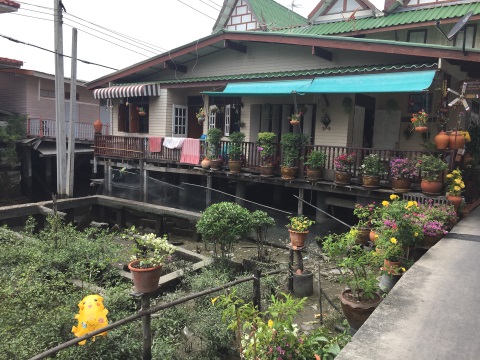
Scenes from the old Ban Sakhla community We found a sign showing the way to a second museum which turned out to be another interesting source of information. 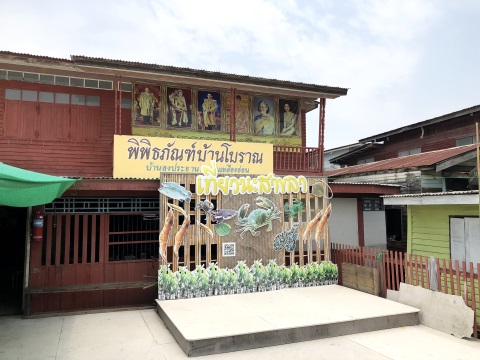
The museum in the old Ban Sakhla Community Contents Ban Sakhla Community The museum is in a house that displays preserved marine life with several snakes thrown in! But it was here that we learnt more about this old community. We were fortunate to meet Lung (uncle) Prathan the owner of the house and museum and he had more to add about the Ban Sakhla. 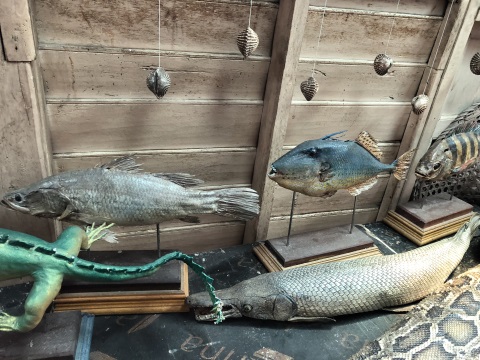
Preserved fish on display Lung Prathan is 72 and still hale and hearty. He was born in Ban Sakhla and so were his parents. Like many of the residents here he first engaged in salt farming. 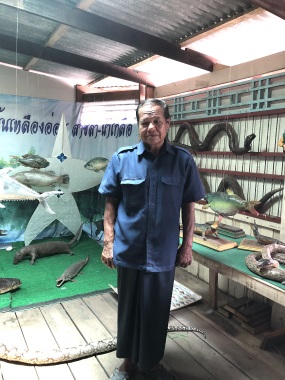
Lung Prathan But salt farming was labour intensive, the quality of salt poor and the profit margins low. Later many residents switched to crab and prawn farming which was more lucrative. Currently Lung Prathan is rearing cockles which he supplies to the market. There are several cockle shells on display in his museum. 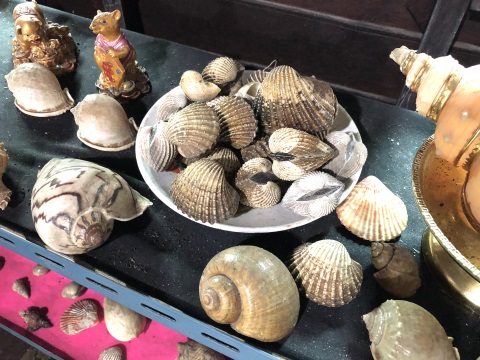
Cockle shells and some of them are huge According to Lung Prathan it was only 30 years ago** that a proper road was built linking Ban Sakhla with the mainland and electricity and water supplies made available. Before that the residents travelled around in boats and used kerosene lamps and collected rain water in jars for consumption. **This is probably a more permanent road built by the government and not the road built by the villagers in 1966 as mentioned earlier We then toured the house downstairs and viewed some of the family photos. After the visit we had a plate of pad thai (fried glass noodles) from the kitchen run by Lung Prathan's sister. 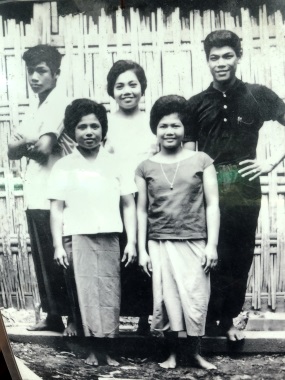
Lung Prathan (extreme left) with his brothers and sisters Many people still use boats to move from one place to another, it's faster than walking or riding a bike through the narrow lanes. 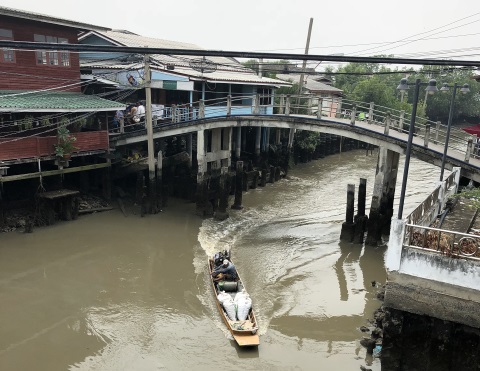
Ban Sakhla today This was a tour of a very special community in Thailand that has managed to remain intact after more than two centuries and preserve its heritage as well. It's definitely worth a weekend visit. 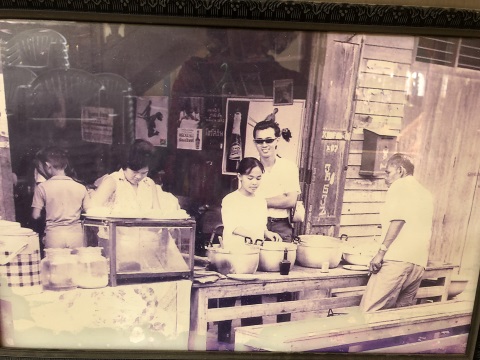
Preserving memories of life back then Contents Our thanks A big thank you to Lung Prathan and his family for hosting us in their home and for sharing information on his livelihood and his community with us. Visiting his home has made the visit to Ban Sakhla complete. Contents Map to Ban Sakhla If the map doesn’t appear, click on this link View the satellite version of the map to see Ban Sakhla and the surrounding area to appreciate how isolated the community is. There are only two road links to the mainland. Address Wat Sakhla 19 Mu 3 Tambon Na Kluea Amphur Phra Samut Chedi Samut Prakarn Opening hours of Ban Sakhla Museum Open every day from 0800 – 1800 hours If you wish to hire a boat for a canal tour of Ban Sakhla, please call 081-556-8985. How to get there By car From Krung Thonburi Road - BTS Wong Wian Yai – Somdet Phra Chao Taksin Road (Highway 303) – Suk Sawat Road – turn right at the clock tower – turn right again to Khlong Sapphasamit Road which runs along the canal of the same name – keep going till you reach a shrine with many deities – turn left, cross the bridge and proceed to Wat Sakhla. Contents Next month Pridi Banomyong Memorial House, Ayutthaya. If you enjoyed reading this e-zine, please forward it to a friend. If you received this from a friend and found it interesting, please subscribe at Bangkok Travelbug. What do you think of the Bangkok Travelbug? We love to hear from you What other subscribers have said Till next month then. Eric Lim Tour Bangkok Legacies Find us on Facebook My Journey through Thailand Part I The First Steps This is my second e-book and the first in the series of travel journals on my trips to explore the various provinces in Thailand. This edition, which covers my travels from late 2009 to mid-2013, will guide you to historical sites, cultural monuments and exquisite Thai handicraft, across a vast spectrum of cultural and ethnic diversity. You can have a virtual tour with this e-guide book or take the first steps yourself in this journey through Thailand. My Kindle e-book 
Copyright@2008-2018 Tour Bangkok Legacies All rights reserved
|
| Back to Back Issues Page |
